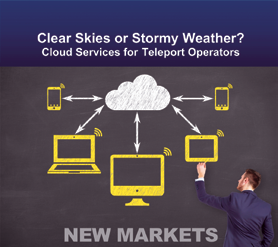Worldwide, cloud service providers generated US$220 billion in revenue in 2016, according to Gartner, and will nearly double that to US$411 billion by 2020.

With acres of server capacity and sophisticated systems to manage it, cloud providers offer their customers flexibility, scalability to burst traffic for high demand, and pay-per-use pricing.
The most profound impact of the cloud may be its ability to turn capital expenses into operating expenses. This offers major advantage when starting up a service and substantially reduces the risks to the business in the event a new service fails to meet its objectives.
The Cloud Strategy
WTA will soon publish the organization’s first report on the adoption of cloud services — Clear Skies or Stormy Weather?
The report will argue that every teleport operator today needs a cloud strategy because of the impacts the cloud can have on a teleport’s business.
In the media space, interconnection with a cloud provider allows one teleport operator to offer more flexible occasional-use video services, including the ability to quickly scale up during peak demand, along with a better cost structure.
Using a public cloud to encode video may cost more per hour than on-premise technology, but it is well-suited to the unpredictable demand of occasional-use.
“As our business transitions from long-term commercial contracts to customers only willing to commit to three months of service at a time,” said an executive, “we can use a cloud solution to spin it up, deliver service and walk away without worrying about capex. Where it could take months to set up a channel before, we can literally set it up faster than the customer can make the final decision. Time-to-market shrinks from 30 days to under 60 minutes.”
New Markets
Partnering with cloud providers can provide access to new customers and new opportunities from existing ones.
The big cloud providers have a massive network of customers and can help them market services to each other. The cloud operators also need what teleport operators have: the ability to connect to satellite and other dedicated transmission paths, and data processing capacity that puts workload closer to end-users.
Their rich software toolkits can also help expand existing business. “A broadcaster needs multiple ways of getting content to the consumer,” said a contributor, “and lots of different ways to monetize the content to pay for the additional distribution cost. As their service provider, we need to offer IP delivery across all formats and networks. We need to master analytics so that we become their source for answers about viewer demographics and viewing habits, which is so critical to monetization.”

Getting More from IT
The cloud offers teleport operators the same potential value as any other enterprise: the chance to reduce costs, increase agility and gain access to valuable applications.
One respondent turns to cloud providers for special IT requirements. “If we are doing a customer-facing portal website for their services, often we will host it in the cloud, rather than us spinning up database and web servers in-house. It’s faster and takes advantage of the database, web hosting and other services the cloud provider already offers.”
A cloud provider can also act as a highly secure platform for a teleport operator and customer to interconnect systems that need to talk to each other.
One respondent described a customer’s request to integrate its in-house scheduling system with the playout system at the teleport. Directly connecting the platforms would create staffing, operational, legal and security issues for both companies; however, by interfacing the systems through an application programming interface (API) in the cloud protects both companies’ IT infrastructure while meeting the customer’s requirements.
You Must be In It to Win It
Cloud providers also represent a new source of competition. Media-centric operators already report that transcoding, packaging, playout and workflows are beginning to migrate to the big cloud providers.
Integrating cloud services into your operations also requires new skills to manage properly and the right approach to integration. Operators today have no choice but to understand the cloud thoroughly, adopt it intelligently and adapt to the changes it will bring to the business.
worldteleport.site-ym.com/

Robert Bell has over 30 years of experience as an association manager and business consultant for both nonprofit and profit-driven and organizations operating in the IT outsourcing, telecommunications, and financial services industries.
Mr. Bell has led business development missions and conducted workshops and Master Classes in the Americas, Europe and Asia. A regular blogger, he has written for The Municipal Journal of Telecommunications Policy, IEDC Journal, Telecommunications, Asia-Pacific Satellite, Digital Communities, and Asian Communications. He is a frequent speaker and moderator at industry conferences including SATELLITE, NAB, SATCON, ICF’s annual SUMMIT and the Global Forum.
A co-founder of the Intelligent Community Forum, he is also the author of market studies and reports including Benchmarking the Intelligent Community, Teleports in a Gigabit World, and How to Buy Satellite Capacity. He is the co-author, with Louis Zacharilla, of B2B Without the BS, a guide to sales and marketing in the unique business-to-business sector; of Broadband Economies: Creating the Community of the 21st Century; and of Seizing Our Destiny.


